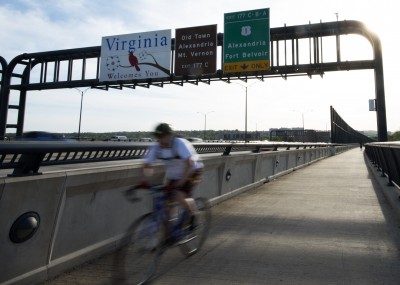Two recent traffic deaths in the region — the locally famous “Running Man” in Charlottesville and a cyclist pedaling a bike he got as a Christmas present in Montgomery County — help prove a sad truth: We do not take seriously transportation by foot or bike.
Compared with European countries, we are living in the transportation dark ages, and Americans who dare to travel without the protection of metal vehicles are dying because of it.
Consider crosswalks: Although children are taught that the marked lanes near traffic lights are for pedestrians, drivers routinely stop their cars within crosswalks, not behind them. The fact that so many crosswalks have so few pedestrians reinforces this complacency. In many locations, the white crosswalk lines are allowed to fade almost to oblivion, as local governments give low priority to such maintenance. As for mid-block crosswalks, such as the deadly one in Montgomery County, drivers pay even less attention, even when they are marked with signs reading: “State Law: Stop for Pedestrian Within Crosswalk.” It is telling that the signs refer only to people “within” the crosswalk, not to anybody “at” the crosswalk.
In Europe, drivers are taught that it is required social custom to pay attention to pedestrians on sidewalks. In Switzerland, for example, where frequent mid-block crosswalks are meticulously maintained with glowing yellow lines, almost every driver will come to an abrupt halt for any pedestrian waiting at a mid-block crosswalk.
A major hazard in cities, including the District, where pedestrians are more common, is drivers making right turns. Drivers are understandably eager to make their turns between clumps of pedestrians before the light turns red. The conflict between walkers and turners is one reason there were more than 4,000 U.S. pedestrian traffic deaths in 2014 — with more than 50 in this area. Many cities in Europe, such as Madrid, solve the right-turn problem by moving the crosswalk somewhat away from the intersection and creating a signal cycle in which only pedestrians are allowed through. Such a sensible solution requires spending taxpayer money and creating some inconvenience for drivers — things our local governments seem unwilling to do.
For cyclists here, riding naturally creates paranoia — there were more than 700 U.S. cycling deaths in 2013. This contrasts with the attitude in Europe, where far more people ride bikes but far fewer people wear helmets. One reason is that cycling in Europe is commonplace, not a curiosity.
Bicycles are too slow for auto traffic and too fast for sidewalks. How to resolve this problem? In cities such as Vienna, the government has created wider sidewalks (at the expense of a lane of auto traffic in many instances) with separate lanes for cyclists and pedestrians clearly marked. In the heart of the city, the Ringstrasse route can be taken by foot, bike, tram, subway (with more frequent trains than Metro on evenings and weekends) or car — each with dedicated paths. The result is that cycling is a routine event for Viennese of all ages and shapes, not just for children or fitness buffs.
How can we become more like Europe? Our governments should spend money to build dedicated bike lanes on important routes, even if it takes away a lane from cars. We should mark all crosswalks with bright yellow paint, meticulously maintain them and regularly ticket crosswalk-violating drivers. And we should change traffic signal cycles in busy areas so that pedestrians may cross unimpeded, which happens at a few intersections in the D.C. area. These steps would help teach Americans that walking and cycling aren’t curiosities, but rather forms of travel equal to moving by car and truck. By creating a virtuous circle of greater usage and greater comprehension, we would take walking and biking seriously — and save lives.
The writer walks and bikes near his home in Takoma Park and teaches land-use law at Stetson University College of Law in Florida.
Source: The Washington Post
January 22, 2016
By Paul Boudreaux, Photo: Bonnie Jo Mount
https://www.washingtonpost.com/opinions/dc-should-learn-from-europes-approach-to-walking-and-cycling/2016/01/21/5c24625a-b4c7-11e5-a76a-0b5145e8679a_story.html











